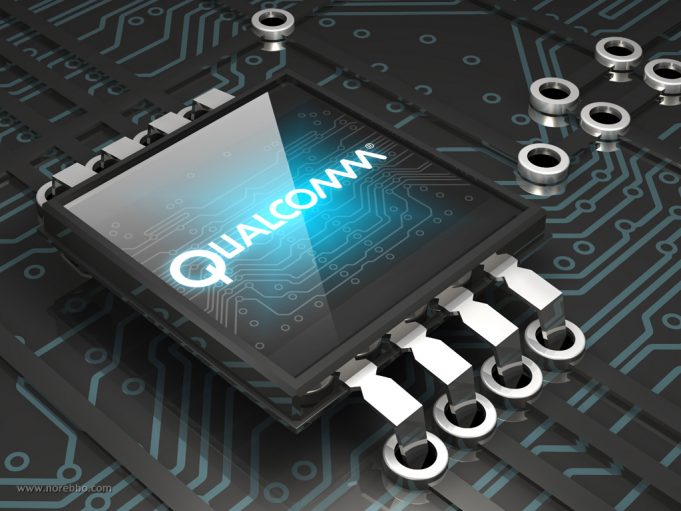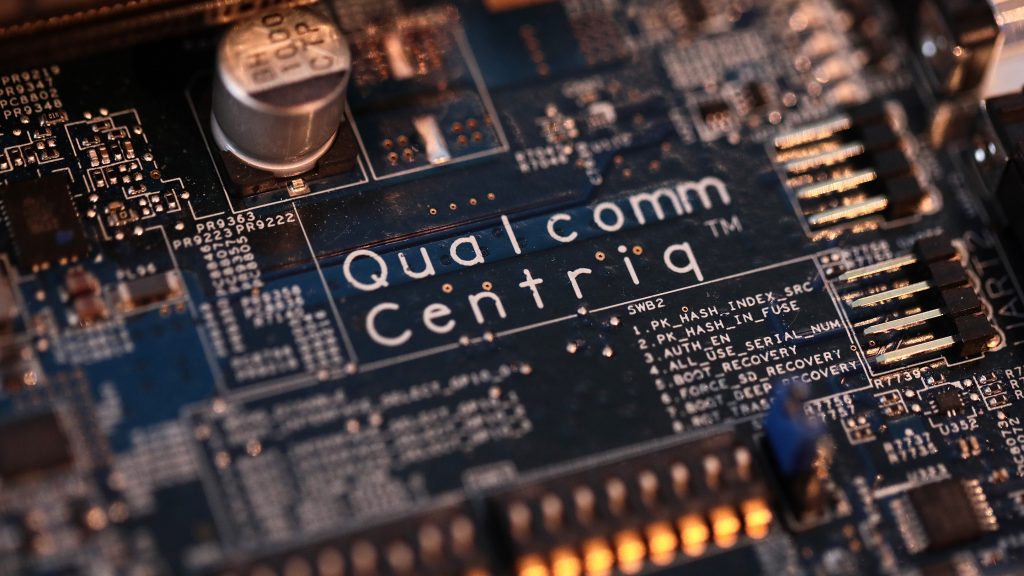QUALCOMM Incorporated develops, designs, manufactures, and markets digital communications products and services in China, South Korea, Taiwan, the United States, and internationally.
The company operates through three segments:
- Qualcomm CDMA Technologies (QCT);
- Qualcomm Technology Licensing (QTL); and
- Qualcomm Strategic Initiatives (QSI).
The QCT segment develops and supplies integrated circuits and system software based on code division multiple access (CDMA), orthogonal frequency division multiple access (OFDMA), and other technologies for use in voice and data communications, networking, application processing, multimedia, and global positioning system products.
The QTL segment grants licenses or provides rights to use portions of its intellectual property portfolio, which include various patent rights useful in the manufacture and sale of certain wireless products comprising products implementing CDMA2000, WCDMA, CDMA TDD, and/or LTE standards, as well as their derivatives.
The QSI segment invests in early-stage companies in various industries, including digital media, e-commerce, healthcare, and wearable devices for supporting the design and introduction of new products and services for voice and data communications.
The company also develops and offers products for implementation of small cells; mobile health products and services; software products, and content and push-to-talk enablement services to wireless operators; and development, and other services and related products to the United States government agencies and their contractors. In addition, it licenses chipset technology and products for data centers. QUALCOMM Incorporated was founded in 1985 and is headquartered in San Diego, California.
- source: capremedia.com
Business Analysis of Qualcomm
The Technology Sector is witnessing a major shakeup, new age business models in the industry are transforming both customers and businesses. Faced with this uncertainity, companies are investing resources to transform their business. An in-depth business analysis is a valuable resource to identify and articulate the need for a business model change.
At R&P Research we believe, the starting point for a business analysis is Benchmarking. Business benchmarking can be done at various levels:
- Industry Benchmarking
- Peer Benchmarking
- Disruptors Benchmarking.
In this report, we share the snapshot of how Qualcomm compares against the industry on the major performance indicators. This analysis, along with peer group/disruptors benchmarking and revenue model understanding can help identify growth and cost optimization opportunities to maximize the value delivered by Qualcomm to its stakeholders.
R&P Research Industry Intelligence Platform provides historical data for last 15 years with an easy to use benchmarking interface for an in-depth comparative business analysis.
Here is the performance snapshot of Qualcomm with an interactive chart.
- Revenue Growth: Qualcomm reported a revenue growth of -6.8% year-on-year during 2016. Semiconductor Industry grew at 5.9% in the same period
- COGS share of Revenues: As a percentage of revenue, Qualcomm spent 41.4% of its total revenues on COGS. Semiconductor industry average (COGS share of revenue) in the same period was 49.2%
- R&D; share of Revenues: As a percentage of revenue, Qualcomm spent 21.9% of its total revenues on R&D.; Semiconductor industry average R&D; spending in the same period was 18.4%
- SG&A; share of Revenues: As a percentage of revenue, Qualcomm spent 10.1% of its total revenues on Sales, Marketing, and General Administration (SG&A;). Semiconductor industry average SG&A; spending in the same period was 12.4%
- Inventory share of Revenues: As a percentage of revenue, Qualcomm spent 6.6% of its total revenues on Inventories. Semiconductor industry average Inventory spending in the same period was 12.5%
- Accounts Payable share of Revenues: As a percentage of revenue, Qualcomm invested 7.9% of its total revenues on Accounts Payable (A/P) Semiconductor industry average Accounts Payable investment in the same period was 8.8%
- Accounts Receivable share of Revenues: As a percentage of revenue, Qualcomm invested 9.4% of its total revenues on Accounts Receivable (A/R). Semiconductor industry average Accounts Receivable investment in the same period was 12.3%
- PP&E; share of Revenues: As a percentage of revenue, Qualcomm invested 9.8% of its total revenues on Property, Plants, and Equipments (PP&E;). Semiconductor industry average PPE investment in the same period was 36.5%
- Intangibles share of Revenues: As a percentage of revenue, Qualcomm invested 39.0% of its total revenues on Intangibles. Semiconductor industry average Intangibles investment in the same period was 56.1%
- Net Margins: Qualcomm Net Margins in the year 2016 were 24.2%. Semiconductor industry average Net Margins in the same period were 11.6%
- source: fortune.com
Sector and Industry Association of Qualcomm
For the purpose of performance benchmarking of a company with a sector or industry average, R&P; Research associates every company with one sector and one industry. An industry consists of companies with related/similar business models. A sector comprises of a group of related/similar industries.
Qualcomm is associated with Technology Sector and Semiconductor Industry.
Technology sector is comprised of the following industries: Computers Systems and Peripherals; Software; Semiconductor; IT Consulting and Outsourcing Services; Networking Equipment and Services; Internet; Other. The definitions for each of the industries is as follows:
- Computers Systems and Peripherals industry includes companies primarily engaged in manufacturing of personal computers, servers, mainframes, workstations, and other computer accessories and peripherals such as storage drives, mice, keyboards and printers. It also includes manufacturers of mobile phones and tablets.
- Software industry includes businesses providing software products such as operating systems, productivity suites, enterprise software, data and analysis software, advertising and marketing software, engineering and manufacturing software, networking software, and IT management software. It also includes companies providing industry-specific software focused on different sectors such as Financials, Automotive, Telecom, Utilities, Travel, Real Estate, Media, and Publishing.
- Semiconductor industry includes companies primarily engaged in manufacturing and distribution of semiconductor products such as microprocessors, chipsets, motherboards, flash memory, and wired and wireless connectivity products. It also includes companies that provide semiconductor equipment and services to the semiconductor industry.
- IT Consulting and Outsourcing Services industry includes companies primarily engaged in providing information technology consulting and outsourcing services to other businesses. The services include IT consulting, systems integration, application development and management, IT infrastructure management, and network operations management.
- Networking Equipment and Services industry includes companies primarily engaged in manufacturing and distribution of networking and communications equipment for transporting data, voice, and video traffic across intranets, extranets, and the Internet. The key products include routers and switches for local and wide-area networks, cable modems, teleconferencing equipment, and wireless access points.
- Internet industry includes Internet-based businesses providing products and services such as search engines, social networking, web hosting, email, domain name registration, and eCommerce. It also includes industry information/services portals focused on different sectors such as Financials, Automotive, Travel, Health, Real Estate, Media, and Publishing.
- Other industry includes companies providing products such as photocopiers, fax machines, point of sale machines, audio/video technologies, and video games. It also includes technology companies that are not part of other six technology industries.
- source: tecpartners.co.uk
Industry Ranking of Qualcomm
With $23.6 billion revenues, Qualcomm ranked number 2 of all the companies in the US Semiconductor industry. There were a total of 70 public companies in the US Semiconductor industry that had revenues greater than $50 million during 2016.
The top-10 companies in the US Semiconductor industry by revenues during 2016 were:
- Intel ($59.4 billion)
- Qualcomm ($23.6 billion)
- Texas Instruments ($13.4 billion)
- Broadcom ($13.2 billion)
- Micron Technology ($12.4 billion)
- Applied Materials ($10.8 billion)
- Lam Research ($5.9 billion)
- Nvidia ($5 billion)
- AMD ($4.3 billion)
- On Semiconductor ($3.9 billion)
Business Model Analysis (BMA) Framework
We use the following framework to assess the business model of a company. Business Model Analysis framework can be used by organizations to articulate growth strategies and identify cost optimization opportunities. Technology and consulting companies can use this framework to identify the value drivers and pain points of their targeted customers. Entrepreneurs can use this framework to understand the language of business and identify promising business opportunities. This framework can be used by any professional aspiring to take up a leadership role to better understand the businesses challenges, articulate growth strategy, and monitor the business improvement requirements for the organization.
Industry Peers and Competitors of Qualcomm
Intel (INTC) Business Analysis – Analyze Historical Performance, Strategic Priorities, And…
Intel Corp with $59 billion revenues in the year 2016 was the number 1 Semiconductor company. Read this report to know the top competitors of Intel and identify growth and cost optimization opportunities of Intel
Texas Instruments (TXN) Business Analysis – Analyze Historical Performance, Strategic Priorities,…
Broadcom (AVGO) Business Analysis – Analyze Historical Performance, Strategic Priorities, And…
Micron Technology (MU) Business Analysis – Analyze Historical Performance, Strategic Priorities,…
Applied Materials (AMAT) Business Analysis – Analyze Historical Performance, Strategic Priorities,…
Lam Research (LRCX) Business Analysis – Analyze Historical Performance, Strategic Priorities,…
Revenues Analysis
Qualcomm (QCOM) Revenues And Revenue Growth From 2012 To 2016
Qualcomm (QCOM) Revenues And Revenue Growth From 2002 To 2016
Qualcomm (QCOM) Revenue Growth Comparison With Industry Growth From 2012 To…
Profit Analysis
Qualcomm (QCOM) Net Profit And Net Margin From 2012 To 2016
Qualcomm (QCOM) Net Profit And Net Margin From 2002 To 2016
Qualcomm (QCOM) Net Profit Margin Comparison With Industry From 2012 To…
Cost & Expenses Analysis
Qualcomm (QCOM) Cost of Sales (COGS) Analysis From 2012 To 2016
Qualcomm (QCOM) Research & Development (R&D) Spending Analysis From 2012 To…
Qualcomm (QCOM) Sales, Marketing, General & Administrative (SG&A) Spending Analysis From…
Working Capital Analysis
Qualcomm (QCOM) Inventory Spending Analysis From 2012 To 2016
Qualcomm (QCOM) Accounts Receivable (A/R) Analysis From 2012 To 2016
Qualcomm (QCOM) Accounts Payable (A/P) Analysis From 2012 To 2016
Asset Management Analysis
Qualcomm (QCOM) Property, Plant & Equipment (PP&E) Investment Analysis From 2012…
Qualcomm (QCOM) Intangible Assets Analysis From 2012 To 2016


















